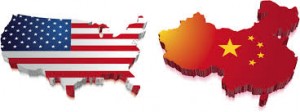US-ASIA.

A 2004 audio presentation article by Graham Daniels.
Much has been discussed in the past with respect to the USA as a super power, however with the emergence of the European Union founded on the existing European communities set up by the treaties of Paris (1951) and the treaty of Rome (1957) and the introduction of the European parliament and a unified currency, the USE (United States of Europe) is now the second power block.
But I suggest there is an emerging third contender.
The United States of Asia (USAsia) will be the new economic kid on the block with the potential to seriously challenge both the United States of America and the United States of Europe for the prize of economic supremacy.
According to the annual report [2002] on Economic Freedom of the World, Asia’s 2 leading business centres, that is Hong Kong and Singapore respectively took first and second place out of 123 nations analysed in the economic freedom ratings summary [2000].
The most populous of the Asian region is obviously China, which is only just beginning to crank up economically. For example China’s Gross National Product (GNP) has grown by about 10% per year since the late 1970’s compared to 3.5% for the United States of America.
For those listening to this briefing that may not know, the population of China is over 4 times that of the USA (1.4 billion verses 300 million).
China’s current purchasing power is just over half of that of the USA economy (6.3 trillion verses 10.7 trillion [in 2003]), and Chinas per capita income is only 13% of that of the USA…but that’s now…. However if China can reach only half of America’s per capita income, and this is not an impossibility, then China’s GNP would be approximately 75% larger than that of USA!…..and that’s just China.
So what does that mean? It means that the Asian block countries, could streak past the USA and Europe as the worlds economic superpower… if they chose to unite!
Add to this the fact that the United States of Asia is uniquely positioned to service the worlds markets, particularly that of the USA and USE. She’s geographically central to both and has at her disposal the one necessity to a market economy that neither the USA or the USE can provide, and that is cheap labour.
In order for the USA and the USE to compete on pricing they will need to access the United States of Asia’s cheap labour force. The dilemma is that in doing so they increase the GDP of Asia
Some would argue that the Asian block countries need USA capital to prime its economic pump and this is obviously what America is banking on, however, recent developments indicate that this is not so.
By way of example China Life in December last year [2003] sold shares in what became the biggest IPO (initial public offering) of that year when it raised just over 3 billion. But, in February 2004, the company became the first state owned company to get sued in the US court for alleged securities violations, and such is now a clear warning to foreign investors in the US as to the hidden costs in going to the USA to raise capital.
The China Life situation is causing many Asian companies to reconsider going to the US to raise funds. For example Shenhua is a huge coal company based in Beijing and in March this year [2004] it announced that it was seeking a 2 billion dollar listing in New York and Hong Kong. According to Finance Asia Publication [April 2004] “sources say that the company is now reconsidering its New York listing in the light of the China Life case. One banker working in Beijing has said that the Shenhua situation reflects the serious concerns among Chinese companies about the legal morass in the US.” At the time of writing the article, Finance Asia reported that a “ further 9 Asian companies were facing law suites in the US in what was described as a litigious free-for-all”.
The bottom line is the USA is locking Asia out of its stock exchange through litigation and legislation but in doing so Asia has discovered that she is more than capable of funding her own commerce and industry as proven by the Korean bank Shinhan when it raised 533 million dollars in one hour through the sale of shares…….all locally.
The flip-side of this is that although Asia may not look to the US for its capital it can still access US capital but they don’t need to go to the US to get it. US investors are investing directly in the Asian markets, as we speak, but doing so on Asian terms.
So the UNITED STATES OF ASIA, in my opinion is emerging as a major third player in the market trade war, and will be gaining strength over the next decade.
Graham Daniels
2004
